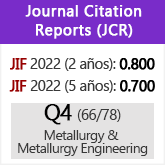Ingeniería de superficies y su impacto medioambiental
DOI:
https://doi.org/10.3989/revmetalm.2007.v43.i1.53Palabras clave:
Modificación superficial, Impacto medioambiental, Recubrimientos, Aplicaciones industrialesResumen
La ingeniería de superficies consiste en la modificación de la microestructura y/o la composición superficial de un componente mediante métodos mecánicos, físicos o químicos, que pueden implicar el aporte de otro material para cambiar las propiedades superficiales del mencionado componente. Una de sus consecuencias más importantes es que permite alargar significativamente, la vida útil de todo tipo de componentes empleados en un gran número de aplicaciones industriales. Por otra parte, contribuye al ahorro energético por permitir el aumento de las temperaturas de combustión consiguiendo una mayor eficiencia, por contribuir a la reducción de peso y por colaborar de forma significativa a disminuir la fricción entre componentes. En el presente trabajo se introduce la ingeniería de superficies, sus diferentes modalidades, algunos ejemplos de sus aplicaciones industriales y las interacciones, positivas y negativas, con el medio ambiente.
Descargas
Citas
[1] ASM Handbook, Surface Engineering, V 5, ASM International, Materials Park, Ohio, EE.UU., 1994, pp. 126-135.
[2] K.G. Budinski, Surface Engineering for Wear Resistance, Prentice Hall, 1988, pp. 120-137.
[3] ASM Handbook, Lubrication and Wear Technology, V 18, ASM International, Materials Park, Ohio, EE.UU., 1992, pp. 861-872.
[4] V. Amigó, Y. Pineda, F. Segovia y A. Vicente, Rev. Metal. Madrid 40 (2004) 403-408.
[5] J.R. Davies, Surface Engineering for Corrosion and Wear Resistance, ASM International, Materials Park, Ohio, EE.UU., 2001, pp. 112-116.
[6] R. Bianco y R.A. Rapp, Metallurgical and Ceramic Coatings, Ed. K.H. Stern, Chapman and Hall, Glasgow, England, 1996, pp. 236-263.
[7] M.F. Stroosnijder e I.F. Norton, Surf. Interf. Anal. 22 (1994) 436-440. doi:10.1002/sia.740220193
[8] ASM Handbook, Surface Engineering, V 5, ASM International, Materials Park, Ohio, EE.UU., 1994, pp. 378-411 y 482-493.
[9] E. Escudero, M.J. Bartolomé, V. López, J. Simancas, J.A. González, M. Morcillo y E. Otero, Rev. Metal.Madrid 41 (2005) 133-138.
[10] J.W. Dini, Electrodeposition: The Materials Science of Coatings and Substrates, Noyes, (1993)
[11] G. O. Mallory y J.B. Haidu, Electroless Plating: Fundamentals and Applications, American Electroplaters and Surface Finishers Society, INC., EE.UU., 1990.
[12] A.R. Marder, Prog. Mater. Sci. 45 (2000) 191-275. doi:10.1016/S0079-6425(98)00006-1
[13] H.E. Towsens, L. Allegra, R.J. Dutton y S.A. Kriner, Mater. Perform. (1986) 36- 46.
[14] D. Mattox, Handbook of Physical Vapour Deposition Processing (PVD), Lattice Press, Sunset Beach, CA, EE. UU., 1998.
[15] K.L. Choy, Prog. Mater. Sci. 48 (2003) 57-170. doi:10.1016/S0079-6425(01)00009-3
[16] M.R. Dorfman, Ad. Mater. Proces. 160 (2002) 66-68.
[17] L.J. Li y J. Mazumder, Laser Processing of Materials, Eds. K. Mukherjee y J. Mazumder, The Metallurgical Society of AIME, Warrendale, PA, EE.UU., 1985, p. 35.
[18] G.P. Rodríguez, M. Checa y J.J. De Damborenea, Rev. Metal. Madrid Vol. Extr. (2005) 513-517.
[19] S. Grainger, Engineering Coatings, Design and Applications, Abington Publishing, 1989, p. 33.
[20] J. Bentley Y G.P.A. Turner, Química y tecnología de pinturas y revestimientos, A. Madrid Vicente Ediciones, Madrid, España, 1999.
[21] J.D. Gad, J.F. Nejedlik y L. D. Graham, Electrochem. Technol. 6 (1968) 307-315.
[22] J.R. DavueS, High Temperature Coatings for Superalloys, ASM Specialty Handbook: Nickel, Cobalt and their Alloys, ASM international, Materials Park, Ohio, EE.UU., 2000, pp. 281-290.
[23] P.A. Dearnley, J. Eng. Med. 213 (1999) 107-135. doi:10.1243/0954411991534843
[24] E. Peón, A. Jiménez-Morales, E. Fernándezescalante, M.C. García-Alonso, M.L. Escudero Y J.C. Galván Rev. Metal. Madrid Vol. Extr. (2005) 479-482.
[25] G. Barbezat, Int. J. Automot. Technol. 2 (2001) 47-52.
[26] Hot Deep Galvanizing for Corrosion Protection of Steel Products, American Galvanizers Association (1989)
[27] I. Kleiman y Z. A. Iskanderova, Proc. 8th Int. Symp. Mat, in a Space Environment and 5th Internat. Conf. Protection Materials Structures LEO Space Environment, ESA, (2000).
[28] R. Hauert, J. Patscheider, Ad. Eng. Mater. 2 (2000) 247-259. doi:10.1002/(SICI)1527-2648(200005)2:5<247::AID-ADEM247>3.0.CO;2-U
[29] M. Kupckyk y W. Misiak, Rev. Metal. Madrid Vol. Extr. (2005) 483-487.
Descargas
Publicado
Cómo citar
Número
Sección
Licencia
Derechos de autor 2007 Consejo Superior de Investigaciones Científicas (CSIC)

Esta obra está bajo una licencia internacional Creative Commons Atribución 4.0.
© CSIC. Los originales publicados en las ediciones impresa y electrónica de esta Revista son propiedad del Consejo Superior de Investigaciones Científicas, siendo necesario citar la procedencia en cualquier reproducción parcial o total.Salvo indicación contraria, todos los contenidos de la edición electrónica se distribuyen bajo una licencia de uso y distribución “Creative Commons Reconocimiento 4.0 Internacional ” (CC BY 4.0). Puede consultar desde aquí la versión informativa y el texto legal de la licencia. Esta circunstancia ha de hacerse constar expresamente de esta forma cuando sea necesario.
No se autoriza el depósito en repositorios, páginas web personales o similares de cualquier otra versión distinta a la publicada por el editor.


















